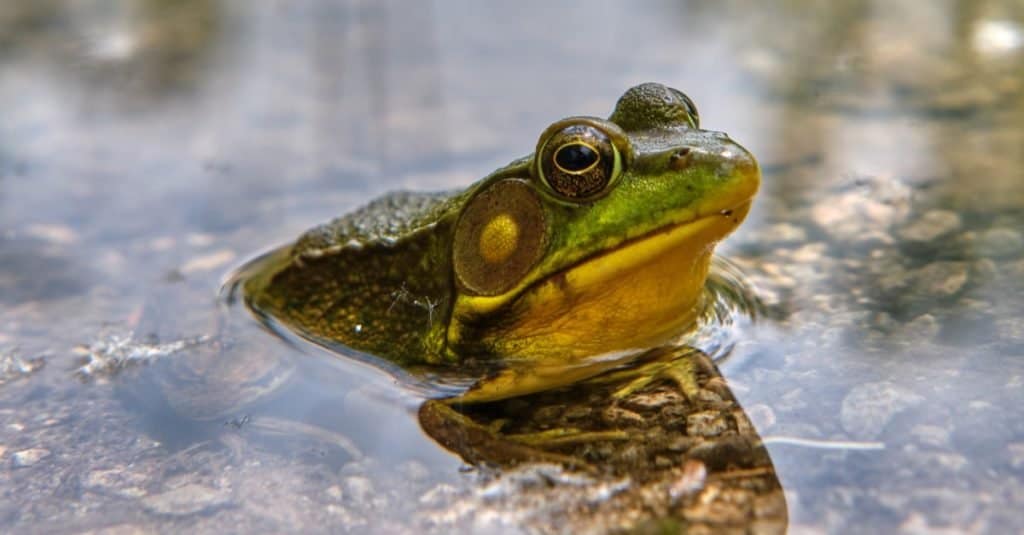Green Frog
.jumbotron {
background-image: url(“https://a-z-animals.com/media/2021/02/Green-frog-header-400×300.jpg”);
}
}
@media only screen and (min-width: 641px) and (max-width: 920px) {
.jumbotron {
background-image: url(“https://a-z-animals.com/media/2021/02/Green-frog-header-470×370.jpg”);
}
}
@media only screen and (min-width: 921px) {
.jumbotron {
background-image: url(“https://a-z-animals.com/media/2021/02/Green-frog-header.jpg”);
}
}
Green Frog
Lithobates clamitans
Green frogs will eat any animal that they can fit in their mouth.
Green Frog Scientific Classification
- Kingdom
- Animalia
- Phylum
- Chordata
- Class
- Amphibia
- Order
- Anura
- Family
- Ranidae
- Genus
- Lithobates
- Scientific Name
- Lithobates clamitans
Read our Complete Guide to Classification of Animals.
Green Frog Conservation Status
Green Frog Facts
- Main Prey
- Insects, fish, small snakes, slugs, and snails
- Name Of Young
- Tadpole
- Group Behavior
-
- Solitary
- Fun Fact
- Green frogs will eat any animal that they can fit in their mouth.
- Estimated Population Size
- 1,000,000
- Biggest Threat
- Water pollution, loss of habitat
- Most Distinctive Feature
- prominent dorsolateral ridges
- Other Name(s)
- Lithobates clamitans, Rana clamitans
- Gestation Period
- 4-14 days to hatch
- Average Spawn Size
- 1,000-1,500 eggs annually
- Habitat
- Swamps, ponds, Lakes, and marshes
- Predators
- Humans, larger frogs, turtles, snakes, birds, raccoons, and otters
- Diet
- Carnivore
- Type
- Amphibian
- Common Name
- Green frog
- Number Of Species
- 2
- Location
- Eastern North America, Canada
Green Frog Physical Characteristics
- Color
-
- Brown
- Blue
- Green
- Skin Type
- Permeable
- Top Speed
- 10 mph
- Lifespan
- 6 years
- Weight
- 28-85 g (0.99-3.00 oz)
- Height
- 6-9 cm (2.4 to 3.5 in)
- Length
- 5–10 cm (2.0–3.9 in)
- Age of Sexual Maturity
- 1 year
- Age of Weaning
- N/A
This post may contain affiliate links to our partners like Chewy, Amazon, and others. Purchasing through these helps us further the A-Z Animals mission to educate about the world’s species..

Spiders that fly! Fish that walk! And 1000+ more incredible animals. Discover them all for FREE
.photo-gallery {
–margin: 0px auto 0px;
–padding: 0px 0px 0px 0px;
}
.gallery-link {
background-image: url(“https://a-z-animals.com/media/2021/02/Green-frog-on-log-1024×535.jpg”);
background-repeat: no-repeat;
background-size: cover;
background-position: center;
height: 500px;
justify-content: center;
text-align: center;
align-items: center;
display: flex;
border: 2px solid #000;
}
.gallery-link img {
height: 50%;
}
@media only screen and (max-width: 768px) {
.gallery-link {
height: 300px !important;
}
}
View all of the Green Frog images!
The green frog is known for being one of the least picky eaters and will consume just about any insect or animal that it can swallow.
One of the most common frogs native to the eastern states and parts of Canada, the green frog can be found just about anywhere there is a body of water for it to call home. This amphibian is known for its rich green hue, but subspecies can include varying shades of brown, bronze, and even blue. The green frog is well-populated and not considered endangered despite rising pollution rates that threaten its habitat. These amphibians prefer to be alone but are known for congregating around breeding season. Green frogs are also common pets due to their calm nature and are easy to care for.
4 Incredible Green Frog facts!
- All species of green frogs tend to have a distinctive green upper lip despite fluctuating color variations
- Males make a distinct mating call that sounds like a sole banjo string being plucked
- Females can produce over 1,000 offspring each year
- Green frogs are the most common type used for frog leg dishes in the culinary world and for scientific purposes
Green Frog Scientific name
The green frog’s most common scientific name is Lithobates clamitans, but it is also referred to as Rana clamitans. The term “lithobates” is derived from the Greek words “litho” and “bates” which mean “rock climber” when combined. The name can also translate to “one who treads on water”. It belongs to the Animalia kingdom and is in the Ranidae family. Lithobates are considered to be a true genus of frogs. Subspecies include the bronze frog and the northern green frog. The northern green frog is native to northeastern parts of North America while the bronze-green frog tends to populate near traditional green frogs.
Green Frog Appearance
Green frogs are famous for their vivid green color. They are usually light in color but can have a muddied appearance similar to that of a bullfrog. However, some green frogs can have light to dark brown tones as well as a distinct bronze appearance. Their skin can feel slimy at times but is generally smooth to the touch, unlike the warty bullfrog. Green frogs often have light yellow bellies with small, black dots scattered throughout. Some can even have tones of blue in their skin. Their bulging eyes help them to see in all directions, making it easier for them to catch prey. Due to their exceptional vision capabilities, adult green frogs are generally able to escape from a potential predator with relative ease.
As an average-sized frog just under five inches long, this species is relatively easy to spot near bodies of water. This is especially true since it can be found out and about both day and night. Compared to other frogs, green frogs have a larger dorsolateral ridge that extends from their eyes down the back of their bodies. In fact, many people use this feature alone to identify the species because it is so distinct. Webbed toes help them maintain their grip and swim more efficiently. Green frogs also have a larger tympanum, or eardrum, than similar species. This is especially true for males. Female green frogs tend to have smaller tympanums that are roughly the size of their eyes or smaller.

Green Frog Behavior
Green frogs and its’ subspecies prefer to live in solitude. However, they do make some exceptions. Breeding season, which is typically in the springtime, is the most time these frogs spend socializing. It is also common for several to live peacefully in the same area and may be found near bullfrog varieties as well as other frogs, as long as there is plenty of prey to catch. These frogs require easy and constant food sources as they practice a waiting technique that requires minimal movement on their part. While hunting, they prefer to sit and patiently wait for potential prey to get close enough for them to grab with their tongue or fit into their mouth.
Male frogs are known for displaying aggressive behavior when it comes to finding a mate. They often growl at other males to send a warning in various intensity levels before attempting to attack. Males omit these alert calls in different levels to send a specific message to other males. This variety of frogs is active both day and night. It is also dormant during the wintertime to conserve energy.
Green Frog Habitat
As one of the hardiest species of frogs, these frogs can thrive virtually anywhere they have access to a stable body of water. Lakes, ponds, and even small bogs are some of the most common areas they can be spotted. Native to the eastern half of the United States and parts of Canada, green frogs prefer areas with plenty of trees and vegetation. This often equates to more potential prey for them to feast on.
Green Frog Diet
This species of frog is carnivorous. It is also flexible when it comes to food choices. These frogs are known for eating virtually any insect or small animal that they can fit inside of their mouth. Some of their favorite prey includes fish, larvae, and even small birds and snakes. Green frogs use a sit and wait hunting tactic, so they prefer to be surrounded by constant food sources that are easily attained.
Tadpoles prefer to eat algae and even zooplankton. As they grow, they begin to consume larger insects before attempting to prey on small animals.
Green Frog Predators and threats
These frogs have plenty of predators. For starters, unhatched eggs are often consumed by aquatic insects such as leeches and dragonflies. Tadpoles and mature frogs alike are targeted by turtles, fish, and a variety of different birds. Small mammals such as raccoons and otters often consume adult green frogs as well.
The largest threat to these frogs is water pollution which can destroy their ability to breed and thrive. Another issue is the loss of habitat due to construction, fires, and other circumstances. However, these threats are considered minimal as this species is nowhere near extinction and programs are in place to protect heavily populated areas.
Green Frog Reproduction and Life Cycle
Female frogs select a mate based solely on the desirability of a territory. A large male is preferred by females, but satellite males, which are smaller and less dominant, often mate with females responding to their counterpart’s calls. Breeding season for green frogs usually occurs in the spring and can last up to three months.
The reproductive process is known as “amplexus” and consists of a male grasping a female’s back and fertilizing the eggs externally. Females first produce the eggs internally where they are nurtured before releasing them. This process leaves the frogs vulnerable to predators as they are easy prey. Eggs are produced in clutches that vary in size. Most clutches contain at least 1,000 eggs. The eggs may be attached to aquatic vegetation but often simply float to the water’s surface making them easy targets for potential predators. Fortunately, most eggs hatch in less than a week’s time. Adult frogs do not care for their young, making them vulnerable to a variety of different aquatic and land predators.
Once the eggs have hatched, the tadpole stage of development begins. This period of growth typically lasts up to two years after which they form into adult frogs. A typical adult can live up to 10 years in captivity, but most found in the wild live for six years or less. Due to their long lifespan and docile nature, these frogs are popular pets that are relatively easy to care for.
Green Frog Population
The population of these frogs has remained consistent despite industrialization and modern pollution sources. While exact figures are unknown, scientists estimate that there are at least 1,000,000 or more of these frogs in existence. Most green frogs reside in the eastern states in areas with plenty of tree and plant life. However, they can also be found in parts of Canada, especially Manitoba.
View all 115 animals that start with G
Green Frog FAQs (Frequently Asked Questions)
Are green frogs carnivores, herbivores, or omnivores?
Green frogs are carnivores.
Are green frogs poisonous?
No, green frogs are not poisonous. However, they may be confused with green tree frogs which are known for being poisonous. However, the toxins produced are not lethal to humans.
Are green frogs endangered?
Green frogs are not currently endangered nor are they at risk for becoming endangered in the anticipated future.
Are green frogs dangerous?
No, green frogs are not dangerous. In fact, many people consider them an ideal pet frog species. Pet green frogs do well in captivity and can even enjoy a longer life span. Northern green frogs are the most common subspecies in the pet trade.
Where do green frogs live?
This species can be found in the eastern half of the United States as well as parts of Canada near virtually any body of water.
Sources
- Virginia Herpotological Society, Available here: http://www.virginiaherpetologicalsociety.com/amphibians/frogsandtoads/northern-green-frog/green_frog.php
- Bio Kids, Available here: http://www.biokids.umich.edu/critters/Lithobates_clamitans/
















